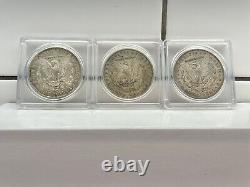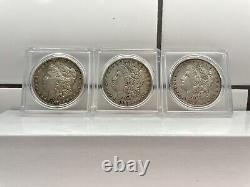Three Morgan Silver Dollars




1882s, 1883, and 1884 Morgan Silver Dollars. The Morgan Silver Dollar has been struck in 90% pure silver and contains a total of. Coins which have an XF grade are considered to have a light amount of wear which is most visible on only the highest points of the coin. Total mintage of 570,247,299 coins released by the United States Mint!
Obverse features Lady Liberty as inspired by Anna Willess Williams. Reverse bears a depiction of the heraldic eagle of the United States. The late 19th century was a tumultuous time period for the economy of the United States, and the US Treasury suffered multiple setbacks in coin production as a result.
A system of free silver coining, which required the Treasury to accept all silver it was presented and return it as coins, was put to an end by the Coinage Act of 1873. In the process, the Seated Liberty dollar ceased to exist. After multiple bills passed Congress trying to solve the problem, the Morgan Silver Dollar was born.
Today, it is one of the most sought-after coins by collectors in America. The coin produced by the US Mint during this tumultuous time period was the Morgan Silver Dollar. Named for the US Mint's Assistant Engraver, George T. Morgan, these silver dollars featured a left-profile image of Lady Liberty on one side and a bald eagle on the other. Morgan Silver Dollars were produced from 1878 until 1904. There was a special, one-year minting in 1921 as well. Morgan's coin featured the image of Lady Liberty on the obverse side. Engraved above her head was the phrase "E Pluribus Unum, " while the year of minting was engraved below. On the reverse side, there was an image of a bald eagle with its wings outstretched. The eagle clasped an olive branch in one talon, and arrows in the other. Engraved above the eagle's head was the phrase "United States of America, " while "One Dollar" was engraved below. The US Mint is responsible for the production of circulation and commemorative coinage for the federal government. Morgan Silver Dollars were produced at the Philadelphia, Carson City, San Francisco, New Orleans, and Denver mints over the years.

